Abstract:
In order to solve the problem that visible light images are greatly interfered by mine lights, car lights, roadway lights, dust and red object in mines, the mine external fire sensing method based on near-infrared and visible light images is proposed. The near-infrared images and visible light images are fused to bring into play the advantages of obvious early flame characteristics in near-infrared images and obvious mid-term flame characteristics in visible light images so as to improve the recognition rate of mine external fire. This paper proposes a mine external fire sensing method based on multiple information fusion of near-infrared image, visible light image, temperature sensor, gas sensor and smoke sensor. The method fuses near-infrared image, visible image and sensor information. The sensor does not need no blind area coverage. Only a certain number of gas sensors, temperature sensors and smoke sensors need to be set up, which has the advantages of being timely, reliable and low-cost.The fire alarms are divided into four categories, including the image, temperature, smoke and gas fire alarms. The image fire alarm information includes near-infrared image and visible light image information. When the fire is detected by near-infrared image or visible light image, the image fire alarm signal is issued.When the temperature exceeds the limit, the temperature alarm signal is issued. When the smoke exceeds the limit, the smoke alarm signal is issued. The gas fire alarm information includes CO, CO2, O2, etc. When CO, CO2 or O2 exceeds the limit, the gas alarm signal is issued. The fire alarms are divided into four levels, including blue, yellow, orange and red, with red being the highest level.When one of the four alarm signals of image, temperature, smoke and gas issued, the blue alarm signal is issued. When two of the four alarm signals of image, temperature, smoke and gas issued, the yellow alarm signal is issued. When three of the four alarm signals of image, temperature, smoke and gas issued,the orange alarm signal is issued. When all four alarm signals of image, temperature, smoke and gas issued, the red alarm signal is issued.




